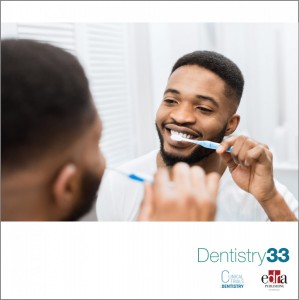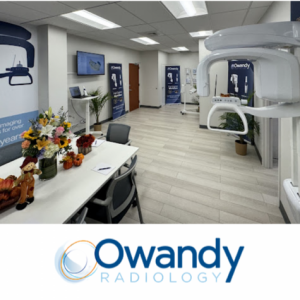
The effects of dental radiographs on pregnant patients
Lara Figini
Recent data from the literature confirms that even today, less than half of pregnant women undergo professional oral health care due to concerns for the safety of their embryo or fetus and fear of dental instrumentation. However, adequate oral hygiene and health during pregnancy is essential.
Nearly 85.7% of obstetricians-gynecologists never examine a patient's oral cavity during routine checkups, nor do they encourage pregnant patients to go to the dentist for preventive checkups or necessary dental care.
One of the major dental concerns from pregnant people is undergoing intraoral radiographs. The safety of dental radiography performed on pregnant patients has been the subject of controversial discussion since the 1960s.
The dose threshold for deterministic birth defects or miscarriage is approximately 200 microsievert-µSv (where 1 mSv = 1000 µSv). It should be noted that the highest in cone-beam computed tomography scans is 212 µSv and that of a full-mouth series (FMX), using D-speed film and round collimation, is 388 µSv.
Little has been written in the literature on the impact of dental radiography and its effects on pregnant people and on birth defects in utero.
Materials, methods
In a review published in August 2022 in the Journal of the American Dental Association, the authors summarized and consolidated data in scientific literature between 1957 and 2021 about the effects that dental ionizing radiation could have on a pregnant patient and uterus making birth defects.
Through PubMed, the studies present in the literature on the subject were searched with a pre-established search strategy with different keywords. Criteria evaluation was performed on the basis of availability, completeness, quality, relevance, technicality (i.e., dental radiography), topicality (i.e. pregnant patients), and usability.
These results were then filtered based on quantitative and qualitative data as well as on the basis of the period (decades in the historical framework). The final review considered cohort studies, systematic reviews, meta-analyses, case reports, and other narrative reviews.
Results
When performed correctly, the amount of ionizing radiation produced during dental radiographic procedures is so low that it is unlikely to reach the teratogenic threshold. Thus, dental ionizing radiation is unlikely to cause birth defects in utero because it has been found to have a deterministic (not stochastic) effect.
The data from this review demonstrates that the necessary dental radiography is safe at any stage of pregnancy, provided that adequate safety equipment is provided and that it is used appropriately.
Conclusions, practical implications
As technology advances, more research can further clarify ionizing radiation safety for pregnant patients and its potential effects on in utero birth defects, improving overall oral health care. The dental community must remain educated about current ionizing radiation safety guidelines to make better-informed decisions and successfully provide proper oral health care to pregnant patients.
For more information: "A historical review of the effects of dental radiography on pregnant patients."
 Related articles
Related articles
The etiology of some of the possible oral manifestations typical of a woman's pregnancy period lies in hormonal changes
Oral Hygiene & Prevention 25 February 2022
Oral disorders and oral hygiene habits in pregnancy: cognitive survey
Authors:Francesco Saverio Ludovichetti, Anna Giulia Signoriello, Veronica Piccoli, Andrea Zuccon, Edoardo Stellini, Sergio Mazzoleni
The gestation period involves a series of changes in all maternal organs and systems, due to hormonal fluctuations that also affect the oral cavity, leading to possible development of diseases such...
Pediatric dentistry 11 June 2021
Fluoride supplementation during pregnancy: is it effective in preventing dental caries in children?
Dental caries in infants and children is one of the most prevalent dental problems of this period with 50% of children have one or more decayed primary teeth by the end of toddler age.
It is well known that during pregnancy, significant fluctuations in the levels of female sex hormones take place. Progesterone and estrogen reach peak plasma...
Products 22 October 2024
Owandy Radiology Relocates its U.S. Headquarters to Larger, Modern Facility in Garden City, NY
Owandy Radiology Inc., a global leader in the manufacture of dental radiology hardware and imaging software, recently relocated its U.S. headquarters to a newly renovated office building at 585...
 Read more
Read more
Editorials 10 October 2025
With proud smiles and crisp white coats, ninety-three learners from the DDS Class of 2029 and the International Dentist Pathway Class of 2028 marked the start of their dental careers at the UCSF...
Periodontology 10 October 2025
Continuous professional development (CPD) in Periodontology refers to the overall framework of opportunities that facilitate a life-long learning practice, driven by the learner-practitioner and...
TheraBreath, the #1 alcohol-free mouthwash brand in the U.S.*, has introduced a new line of dentist-formulated, clinically tested toothpastes designed to support professional oral care...
News 10 October 2025
New officers and trustees were installed at the Minnesota Dental Association’s Leadership Conference on September 19 in Minneapolis.
News 10 October 2025
Smartee Denti-Technology today announced that Professor Gang Shen, its Chief Scientist and Executive President of TaiKang ByBo Dental, has once again been named to the World’s Top 2% Scientists...















